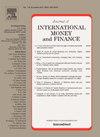Stablecoin price dynamics under a peg-stabilising mechanism
IF 2.8
2区 经济学
Q2 BUSINESS, FINANCE
引用次数: 0
Abstract
Stablecoins are created in various public or private blockchains, and their growing uses include payments, settlements, lending, and even as safe assets in periods of turmoil. They are designed to maintain credible price stability similar to that of a currency pegged to another currency (e.g. the US dollar) operated under a currency board monetary system. To study the peg-stabilising mechanism for stablecoin prices and associated dynamics, this paper uses the analogy of a currency board and the theory of the quasi-bounded target zone model based on the standard flexible-price monetary framework. The solution to the model equation illustrates that the price is more stable in a narrower trading bandwidth and less sensitive to changes in the fundamental variable (i.e. demand for stablecoins) with a stronger stabilising force in the fundamental dynamics. The empirical results using the stablecoin Tether demonstrate that the model can describe Tether’s price dynamics. The mean reversion in the Tether price dynamics representing the stabilising force is positively related to market liquidity in the stablecoin market and volatility in the price of Bitcoin, suggesting that the increased market liquidity and safe haven characteristic of Tether stabilise its price. Tether’s blockchain migration with a larger investor base enhanced the peg-stabilising mechanism. This paper also discusses the implications for prudential treatment of stablecoins, including trading bandwidths, market liquidity condition, and the quality of backing reserves.
钉住机制下的稳定币价格动态
稳定币是在各种公共或私人区块链上创建的,它们越来越多的用途包括支付、结算、贷款,甚至在动荡时期作为安全资产。它们的目的是维持可靠的价格稳定,类似于在货币发行局货币制度下与另一种货币(如美元)挂钩的货币。为了研究稳定币价格的挂钩稳定机制和相关动态,本文使用了货币发行局的类比和基于标准弹性价格货币框架的准有界目标区模型理论。模型方程的解表明,价格在较窄的交易带宽下更稳定,对基本变量(即对稳定币的需求)的变化不太敏感,在基本动态中具有更强的稳定力。使用稳定币Tether的实证结果表明,该模型可以描述Tether的价格动态。代表稳定力的Tether价格动态的均值回归与稳定币市场的市场流动性和比特币价格的波动性正相关,这表明Tether的市场流动性增加和避险特性稳定了其价格。随着投资者基础的扩大,Tether的区块链迁移增强了盯住美元的稳定机制。本文还讨论了对稳定币审慎处理的影响,包括交易带宽、市场流动性状况和支持储备的质量。
本文章由计算机程序翻译,如有差异,请以英文原文为准。
求助全文
约1分钟内获得全文
求助全文
来源期刊

Journal of International Money and Finance
BUSINESS, FINANCE-
CiteScore
4.20
自引率
4.00%
发文量
141
期刊介绍:
Since its launch in 1982, Journal of International Money and Finance has built up a solid reputation as a high quality scholarly journal devoted to theoretical and empirical research in the fields of international monetary economics, international finance, and the rapidly developing overlap area between the two. Researchers in these areas, and financial market professionals too, pay attention to the articles that the journal publishes. Authors published in the journal are in the forefront of scholarly research on exchange rate behaviour, foreign exchange options, international capital markets, international monetary and fiscal policy, international transmission and related questions.
 求助内容:
求助内容: 应助结果提醒方式:
应助结果提醒方式:


